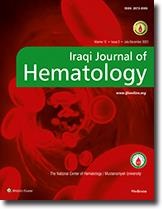Abstract
Background: Pancytopenia is a triad of low hemoglobin, white blood cells and platelets.
Although it is a common clinical problem with an extensive differential diagnosis, there is a
relatively little discussion of this abnormality in major textbooks of internal medicine and
hematology.
Objectives: This study aimed to determines the etiology and clinical profile of pancytopenic
patients attending Nanakaly hospital.
Materials and Methods: During a period of 6 months, 60 pancytopenic patients attended
Nanakaly hospital, their ages ranged between one-81years. A control group of 50 age-matched
apparently healthy person were tested for complete blood picture and reticulocyte count. History,
physical examination and hematological parameters at presentation were recorded. Hematological
profile included hemoglobin, total and differential leukocyte count, platelet count, reticulocyte
count, peripheral blood and marrow smears together with marrow biopsy were assessed.
Pancytopenic cancer patients on chemotherapy were excluded. Pancytopenia was defined as
hemoglobin less than 10g/dl, WBC less than 4 x109/L and platelet count less than 150 x 109/L.
Results: The mean Hb concentration, WBC count and platelet count in studied group were
significantly lower than in control group. Hematological malignancies were the commonest cause
of pancytopenia and accounted for (51.7%), they included: Acute leukemia (35%),
myelodysplastic syndrome (11.7%), hairy cell leukemia (3.3%) and myelofibrosis (1.7%).
Aplastic and megaloblastic anemia each of them accounted for (16.7%), hypersplenism was
responsible for (10%). Other less common causes included enteric fever, kalaazar and secondary
metastasis each of them accounted for (1.7%). Pallor was present in every case. Fever was present
in (63.3%) and (25%) had bleeding manifestations at the time of presentation
.Conclusions: The most common causes of pancytopenia were acute Leukemia, aplastic anemia
and Megaloblastic anaemia, but rare causes like myelofibrosis, enteric fever, kala azar and
secondary metastasis should also be kept in mind.
Although it is a common clinical problem with an extensive differential diagnosis, there is a
relatively little discussion of this abnormality in major textbooks of internal medicine and
hematology.
Objectives: This study aimed to determines the etiology and clinical profile of pancytopenic
patients attending Nanakaly hospital.
Materials and Methods: During a period of 6 months, 60 pancytopenic patients attended
Nanakaly hospital, their ages ranged between one-81years. A control group of 50 age-matched
apparently healthy person were tested for complete blood picture and reticulocyte count. History,
physical examination and hematological parameters at presentation were recorded. Hematological
profile included hemoglobin, total and differential leukocyte count, platelet count, reticulocyte
count, peripheral blood and marrow smears together with marrow biopsy were assessed.
Pancytopenic cancer patients on chemotherapy were excluded. Pancytopenia was defined as
hemoglobin less than 10g/dl, WBC less than 4 x109/L and platelet count less than 150 x 109/L.
Results: The mean Hb concentration, WBC count and platelet count in studied group were
significantly lower than in control group. Hematological malignancies were the commonest cause
of pancytopenia and accounted for (51.7%), they included: Acute leukemia (35%),
myelodysplastic syndrome (11.7%), hairy cell leukemia (3.3%) and myelofibrosis (1.7%).
Aplastic and megaloblastic anemia each of them accounted for (16.7%), hypersplenism was
responsible for (10%). Other less common causes included enteric fever, kalaazar and secondary
metastasis each of them accounted for (1.7%). Pallor was present in every case. Fever was present
in (63.3%) and (25%) had bleeding manifestations at the time of presentation
.Conclusions: The most common causes of pancytopenia were acute Leukemia, aplastic anemia
and Megaloblastic anaemia, but rare causes like myelofibrosis, enteric fever, kala azar and
secondary metastasis should also be kept in mind.
Keywords
bone marrow
Keywords: Pancytopenia
malignant hematology.
